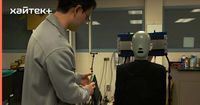A groundbreaking new technology developed by scientists from Pennsylvania State University has made it possible to enjoy music and podcasts without the need for headphones, all while ensuring that friends and family nearby aren’t disturbed. This innovative method, which the team has dubbed "acoustic enclaves," uses an intriguing combination of ultrasonic transducers and an acoustic metasurface, allowing for a unique private listening experience.
The underlying principle of this technology involves two ultrasonic transducers that generate sound in a specific manner. Each transducer creates an ultrasonic beam that is directed along a curved trajectory. These beams intersect at a defined point, where the sound becomes audible solely to a person positioned within that intersection zone. As a result, those in the surrounding area hear nothing, creating a serene oasis of sound for the listener.
To verify the efficacy of this technology, the research team set up tests using a mannequin equipped with microphones placed in its ears. This arrangement simulated the listening experience in various locations along the trajectory of the ultrasonic beam. Additionally, a third microphone scanned the area where the sound is meant to be heard, confirming that audio is only perceptible right at the point where the beams intersect. The results were compelling, leading the scientists to conclude that sound is indeed limited to this virtual environment.
Real-world testing took place in standard rooms, thoroughly examining how the system performed under typical acoustic conditions. This practical testing confirmed that the technology functions well in everyday settings, such as classrooms, cars, or even outdoors. Currently, the system can effectively transmit audio over a distance of about one meter, maintaining a volume level comparable to normal conversation — about 60 decibels.
The implications of this technology are vast. Imagine sitting in your car, enjoying your favorite playlist without the hassle of headphones, all while maintaining tranquility for your passengers. Similarly, in a classroom, students could listen to instructional audio without distracting their classmates. The potential applications for this technology seem limitless.
However, the developers are not resting on their laurels. They have plans to increase the power of the ultrasonic beams, which will enhance both the range and volume of the audio transmission. This next step could revolutionize personal audio consumption even further, allowing listeners to experience music, podcasts, and sounds with more clarity and depth, while still favoring their environment's peace.
“Using our system, you can listen to music or podcasts without the need for headphones and without disturbing those around you,” stated the research team from Pennsylvania State University. They emphasize that this technology does not only signify personal freedom in audio enjoyment but also paves the way for enhanced communicative experiences in public and private spaces alike.
As the concept of privacy in listening evolves, so too does the interaction and experience surrounding personal audio. With attention becoming increasingly divided in our noisy world, innovations like these might just offer individuals a much-needed escape. As scientists continue to fine-tune their methods and explore new avenues for this technology, one could imagine a future where everyone listens effortlessly — together, yet apart.
In closing, while we currently stand on the precipice of this fascinating acoustic technology, it serves as a reminder of our never-ending quest for personal space and enjoyment in an increasingly connected world. As developers aim to broaden the scope and effectiveness of this technology, it’s clear that the acoustic enclaves concept will be a game-changer for music lovers and casual listeners alike.

